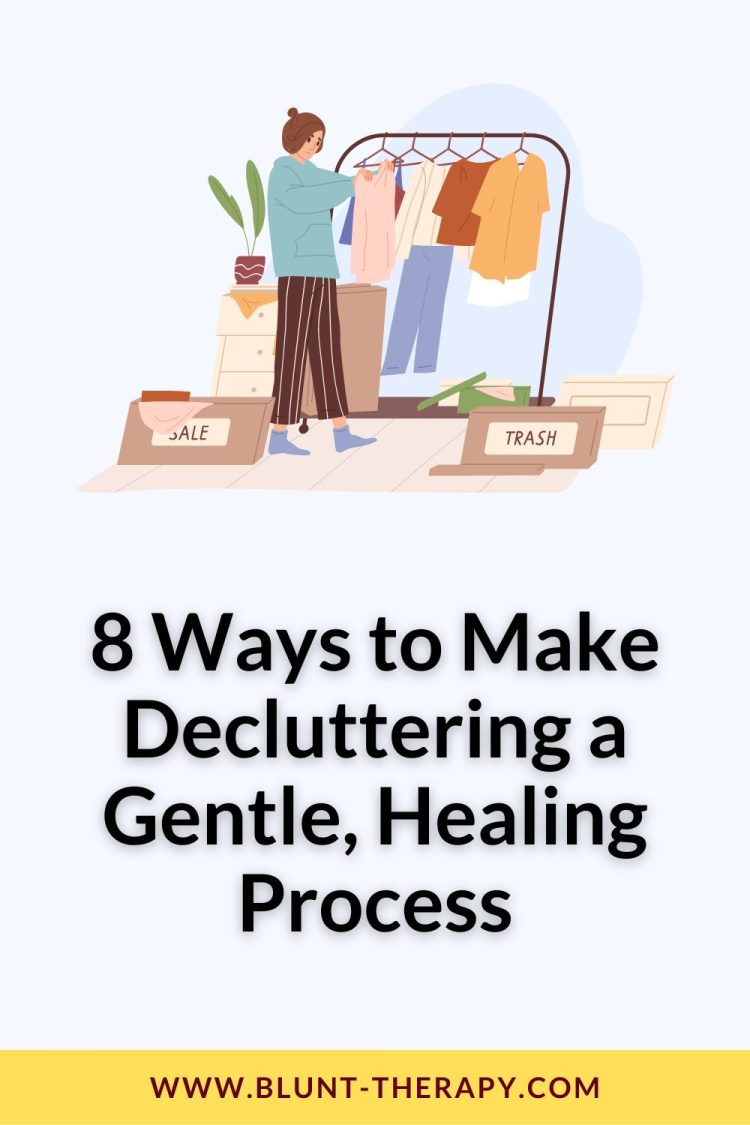Table of Contents
Affiliate link notice: As an affiliate of BetterHelp and other third-party vendors, We will receive compensation if you make a purchase using the links provided on this page. For more information, visit our disclosure page.
Last Updated on October 8, 2025 by Randy Withers
When people talk about decluttering, they often focus on the visible results—tidier closets, organized shelves, or open spaces. But decluttering is about much more than cleaning up. It’s an emotional journey, one that asks you to face memories, confront attachments, and make peace with change.
Every object tells a story, and sorting through them can feel like revisiting chapters of your life. That’s why decluttering can stir grief, nostalgia, and even guilt, especially when it’s tied to a major life transition such as a move, divorce, or loss. This article explores eight gentle, practical ways to declutter your space while also tending to your emotions—so you can create room not just in your home, but in your heart.

1. Choose one small, neutral area to begin
Decluttering often feels overwhelming because we start with the hardest spots: sentimental boxes, inherited furniture, or family photos. You can flip this around and, instead, start with areas where emotions don’t run as high. A junk drawer, a pantry shelf, or a bathroom cabinet are perfect places to begin decluttering because they usually hold everyday items rather than deep memories.
When you clear expired medicine bottles from a bathroom shelf or sort through pens that no longer work in your desk drawer, you get satisfaction and feel that you are making progress without the emotional weight. Those first successes create momentum and make you confident that the process is manageable.
2. Set a timer to make the decluttering sessions manageable
Decluttering can feel endless when you look at an entire room and think about tackling it all at once. That’s where a timer helps. Decide on a set amount of time, whatever is comfortable for you, such as 30 minutes or an hour, and commit to working only within that window. Knowing that there’s a clear endpoint makes the task feel less overwhelming and keeps you from pushing yourself to exhaustion.
Imagine telling yourself, “I only need to focus on this for half an hour.” Even if you don’t finish everything, you’ve made progress. The next time you return, you can pick up right where you left off, without the pressure of tackling it all in one go. Setting up realistic time windows allows you to do a little bit of work almost every day, instead of having to go through an entire, exhausting weekend-long decluttering marathon.
3. Sort your belongings into piles to avoid decision fatigue
When faced with a pile of belongings and the task of deciding what to keep and what to discard, decision fatigue can set in quickly. To keep things simple, use a straightforward sorting method that’s not all black and white. As you go through items, place them into four categories: keep, donate, throw away or recycle, and not sure yet.
This method works in every space, whether you’re dealing with clothes in your closet or cleaning out the garage. For example, you might decide to keep your favorite everyday jeans, donate the jacket you haven’t worn in years, toss expired pantry items, and set aside the box of childhood letters you’re not ready to face. Having a “not sure yet” pile is especially important because it takes the pressure off of making final decisions in the moment.
4. Create a “maybe later” space
Some belongings hold so many memories that it’s hard to know what to do with them right away. Instead of forcing an immediate decision, it can help to create a “maybe later” space. This might be a box where you place items you’re not quite ready to part with — things like your wedding dress, old love letters, or your child’s baby clothes. Label the box clearly and set it aside, knowing you can revisit it when the timing feels right.
For some people, that “maybe later” box is enough. But if your undecided pile starts to take up more room than you’d like – maybe there’s furniture, antiques, and other family inheritances you are trying to sort out – an outside option can help. A self storage unit offers a way to hold onto those meaningful items without crowding your home.
It’s not about avoiding the decision, it’s about giving yourself the space and time to let go at your own pace. And when you go this route it helps to choose the right storage unit size so you have the space you need without paying for more than necessary. If it’s just a few boxes with belongings, then a small, 5’x5’ locker is all that you need. However, if you’re unsure what to do with your grandma’s antique furniture, you could rent a larger unit that can comfortably hold all of it.
5. Ask the right questions before keeping something
When you’re unsure about whether to keep something, a few gentle questions can make the decision clearer. Do you use it often? Does it honestly make your life easier or bring you joy right now? And if you didn’t already own it, would you choose to bring it into your home today?
Take, for example, a kitchen appliance that’s been sitting untouched for years. If you wouldn’t buy it again now and it doesn’t add value to your everyday life, it may be time to let it go. Many of us are reluctant to do so because we spent a lot of money on it – but that’s really not a good reason to keep around something you don’t use. If it still has monetary value, you’re far better off selling it.
The bottom line is that asking such questions keeps you focused on the present, rather than the “I’ll use it someday” scenarios that often keep us holding on to things.
6. Limit the number of sentimental items
Sentimental things are often the hardest to go through because they remind us of the people, places, and moments we hold dear. Letting them go can feel like letting go of the memory itself. But the memories live within you, and you don’t need to keep every single item to honor and carry the past with you.
A helpful approach is to choose just one or two meaningful items per person, event, or stage of life. For instance, you might hold on to your grandfather’s pocket watch but let go of the box of old ties. If you still want to preserve the memories attached to items you release, take photos of them before donating or discarding. That way, you keep the memory without the physical bulk.
7. Let things go with a ritual
Letting go of possessions is easier when you do it with intention. Some people find comfort in saying “thank you” to an item before releasing it. Others feel better donating things in ways that align with their values, such as giving children’s clothes to a local shelter or passing along books to a library or school.
Creating a small ritual that aligns with your goals and your values around letting go can make the process feel less like a painful goodbye and more like a meaningful step forward.
8. Take care of yourself during the process
Decluttering is as emotionally demanding as it is physically tiring. That’s why self-care is essential. Drink water, play calming music, and give yourself permission to rest after each session.
Avoid tackling decluttering projects when you’re already tired or stressed, as the emotional weight will only feel heavier. And if you find yourself overwhelmed by grief while sorting, it’s completely fine to pause and return another day. Progress doesn’t disappear just because you take a break.
Sometimes, having someone else nearby makes the process easier. A trusted friend can sit with you while you sort, offering encouragement or simply companionship. And if the grief that surfaces feels overwhelming, talking it through with a therapist or counselor may provide comfort and clarity.
Decluttering feels like grief because, in many ways, it is. But when you approach it gently, the process can become less painful and more meaningful.
Final Thoughts
Decluttering is rarely just about getting rid of things—it’s about understanding what they represent. Each item you choose to keep or release holds a piece of your history. Letting go doesn’t erase those memories; it simply clears space for new ones to form. When approached gently, decluttering becomes a form of emotional renewal, helping you reconnect with what truly matters.
Remember, there’s no deadline for this work. Move at your own pace. Celebrate each small step, and allow yourself to grieve the transitions that come with change. In the end, decluttering isn’t just an act of cleaning—it’s an act of self-kindness, a quiet reminder that your worth has never depended on what you own, but on how you choose to live.







